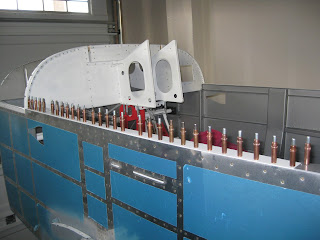The upper forward fuselage assembly (primed last December, January and February and completed back in March) is cleco'd into place. It's easily riveted in solo.
The F-141016 Wiring Channel is then riveted in. The plans call for LP4-3 rivets on the joining of the wiring channel to the F-01451-L/R Tunnel Sides. I was easily able to set AN470AD4-4 rivets with my longeron yoke.
Then the F-01421A/B-L/R Canopy Decks are match drilled into the longerons. It's important to clamp everything down.
Eventually, each hole becomes a #30. The Canopy Decks are removed, deburred and dimpled. You might consider using a 120° dimple die as you'll be putting CS4-4 rivets (I used 100° on accident though it turned out looking well enough). The longerons are then countersunk (a few holes are not, be careful). I supposed if you went with a 120° dimple die, you'd prefer the same angle on your countersinks.
I suggest using a run of tape down the longeron to prevent countersink shavings from impinging into the space between side skin and longeron. I didn't take such a precaution on the right side and spent some quality time removing shavings out of that space.
I opted to paint my canopy decks red, in keeping with my accenting many parts in red (rudder pedals, seat back guide, wiring channel, shoulder harness lugs and red harnesses). The decks are really only visible when the canopy is open. I suspect these parts will get scratched and the paint will eventually look ratty. I'll keep an extra can of spray paint around or I may have the decks painted with the exterior paint when that time comes.
And yet again to prove that I still lack discipline in building my airplane...I had just returned from a 2 week business trip to Japan and was waking up at 3 A.M. What better thing to do than work on the build? So I went to town and put in the canopy decks only to later realize I forgot to lay down sealant along the longeron as called for on 35-11, Step 14. Ugh! I had to drill out all 65+ rivets. Turns out that went much quicker than putting them in. I then had to drill out and remove the rivets a second time as I realized I didn't use enough sealant. Never work on the plane when sleep deprived!
Here's how it turned out. I like the contrast between the unpainted rivets and the painted decks. My guess is the paint won't hold up.
Next the panel frame assembly (completed back on 31-Jan-15) is placed (left). After doing so, I realized I wanted the parts painted since much of this area will be visible when the canopy is opened. So after spending a good hour masking everything off, it got painted (right). In retrospect I wish I would have painted the frame and upper forward fuse assemblies prior to installation.
Then it comes time for the canopy release mechanism. I used a Dremel with a cutting wheel to lop of the ends of the release pins. Then some excessively liberal use of the grinding wheel yielded this. Hopefully too much wasn't taken off. Luckily it's a marginally difficult to replace part if that was the case.
When cutting the C-01435-L/R Canopy Release Pushrods, be careful to include the 1/4" extra on both sides. I did on the longer one, but not the shorter, causing me to buy to a replacement AT6-058X3/8 tube.
Update 23-Dec-16: I later dispensed with the hinges along the top in favor of quarter turn fasteners. That process is illustrated here.
Then the F-01471 Forward Top Skin get cleco'd in place for match drilling the FF-00006A/C Cowl Attach Piano Hinges. As I learned from the FF-00006B-L/R hinges from Section 29, drilling the pilot hole can lead to a poorly aligned hinge. So I dispensed with that step in favor of clamping the part securely after lining it up properly, then drilling/cleco'ing.
Eventually it all gets match drilled. Later the hinges need to be countersunk and the skin/shims/firewall dimpled.
I have elected not to rivet in the forward top skin (a.k.a. "boot cowl") until after wiring of the panel and engine are complete in an effort to support easier access to the firewall and instrument panel assembly. So work on this section terminates in anticipation of a future continuance.


















No comments:
Post a Comment